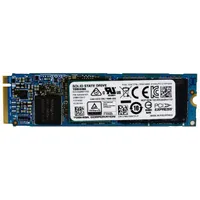BiCS FLASH Preview With Toshiba XG5 NVMe SSD
1TB Performance Testing
Comparison Products
Here it is, the pivotal point in history, old meets new for the first time. We've stacked the charts with nearly every 1TB NVMe SSD available. There is a mix of older, newer, and even impossible-to-find drives on the list. We mixed both MLC and TLC to fill the charts to the brim.
This is a very diverse group. Intel has two products that represent the old and the new. The Intel SSD 750 1.2TB with MLC NAND was one of the first NVMe drives we tested. It has enterprise DNA that makes it big and expensive. The 600p is on the other side of the Intel NVMe camp with low-cost 32-layer 3D TLC technology.
The Galax HOF PCI-E is the only 1TB drive with a Phison PS5007-E7 controller. It's one of the rarest SSDs we've tested; it's only sold in Asia, and even there it's considered rare. There will be other E7 1TB-class products coming to the market very soon, though.
Both Plextor and Samsung have two drives in the charts in both MLC and TLC flavors. On the MLC side, we have the Samsung 960 Pro and Plextor M8Pe. The 960 EVO and M8Se use TLC NAND.
The Toshiba OCZ RD400 is the last drive in the group. We include both the RD400 and RD400a. The RD400 uses an add-in card adapter and the RD400A is an M.2 model.
Sequential Read Performance
To read about our storage tests in-depth, please check out How We Test HDDs And SSDs. We cover four-corner testing on page six of our How We Test guide.
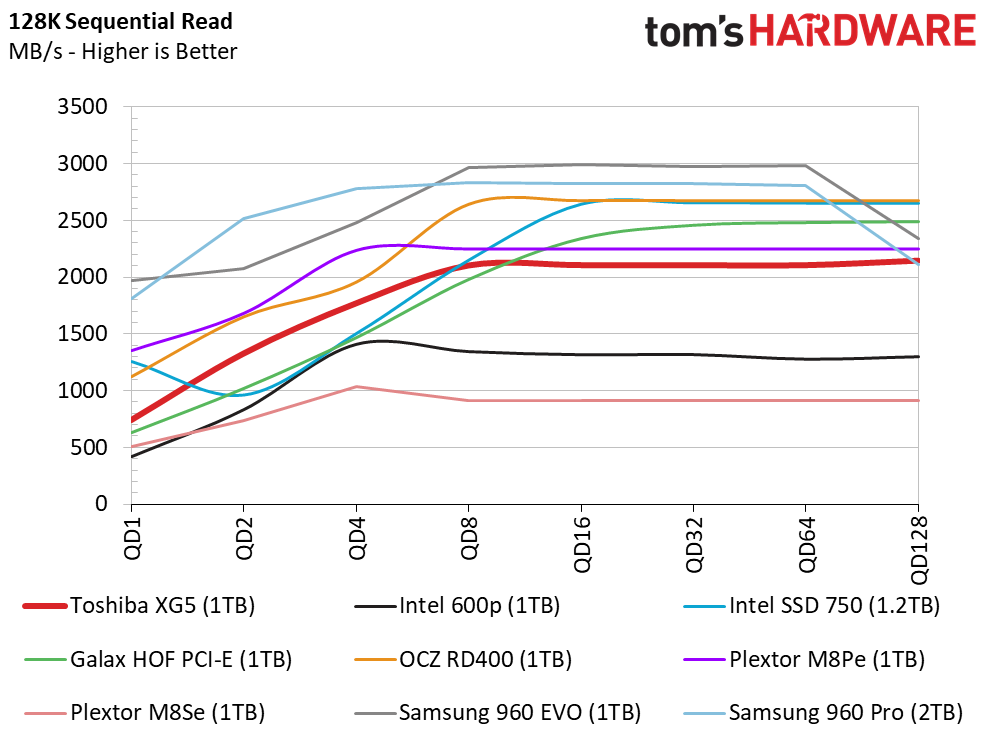

It's possible to reach higher levels of performance with NVMe SSDs by testing with multiple workers, but we still use a single worker for our tests because most software still uses a single thread to access storage devices. We did reach up to 3,000 MB/s of sequential read throughput with multiple workers. That declined to 2,150 MB/s with a single worker.
Get Tom's Hardware's best news and in-depth reviews, straight to your inbox.
The XG5 is still below 1,500 MB/s at queue depth (QD) 2, which is slower than the OCZ RD400. The RD400 arrived well after the XG3 OEM model shipped and includes an optimized NVMe driver. Currently, the XG5 doesn't have an optimized driver.
Sequential Write Performance


We have to admit that the new BiCS NAND just made our jaw drop. Even without an optimized driver, the XG5 just crushed the sequential write test. The QD1 test wasn't all that exciting, but the drive takes off at QD2 and even outperforms the Samsung 960 Pro, which is considered the fastest consumer SSD ever made.
The XG5's sequential write performance is also very consistent as we increase the queue depth. The older XG3 and RD400 both suffered from thermal throttling in this test, as you can see in the RD400 plot.
Random Read Performance



I hate to keep bringing up the optimized driver issue but it's an important aspect. In our testing, random read performance experiences the biggest performance boost from the small piece of driver code. The Toshiba XG5 is at the bottom end of our random read chart with less than 10,000 IOPS at QD1, but we suspect the OCZ version will receive a significant bump. The RD400 is nearly 3,000 IOPS faster at QD1, and the Samsung 960 Pro holds nearly a 7,000 IOPS advantage at the same queue depth.
Random Write Performance


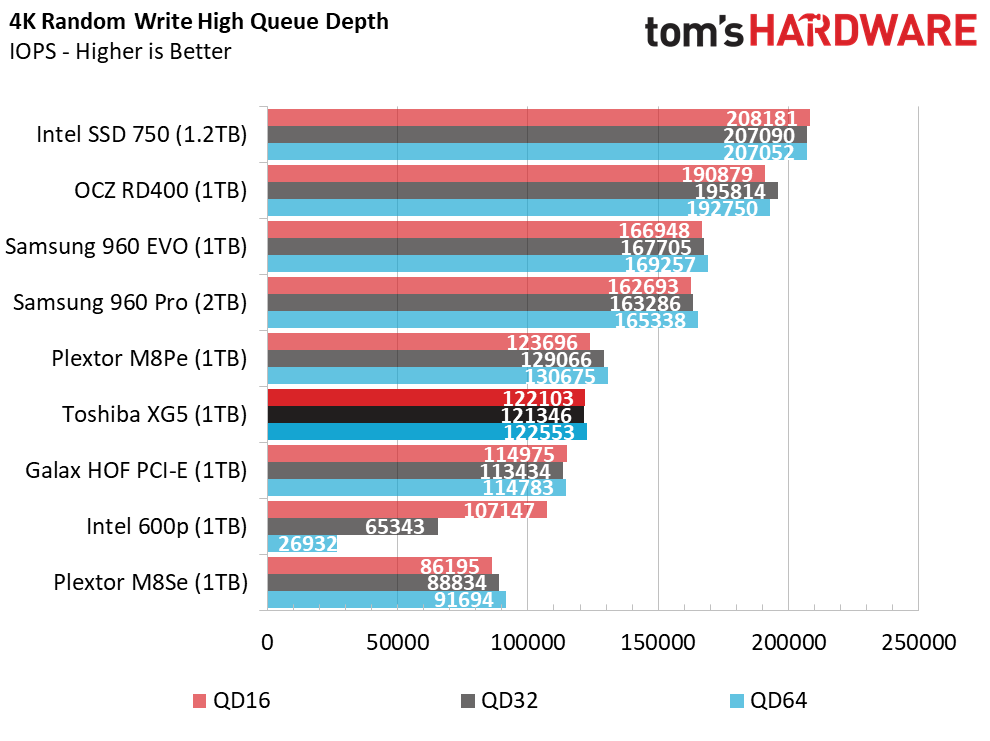
The XG5's random write IOPS performance, which is lower than the RD400, doesn't come as a surprise. TLC will have a very hard time closing the random write gap with MLC flash. All the drives at the bottom of the low-QD chart utilize 3-bit per cell NAND.
80% Mixed Sequential Workload
We describe our mixed workload testing in detail here and describe our steady state tests here.

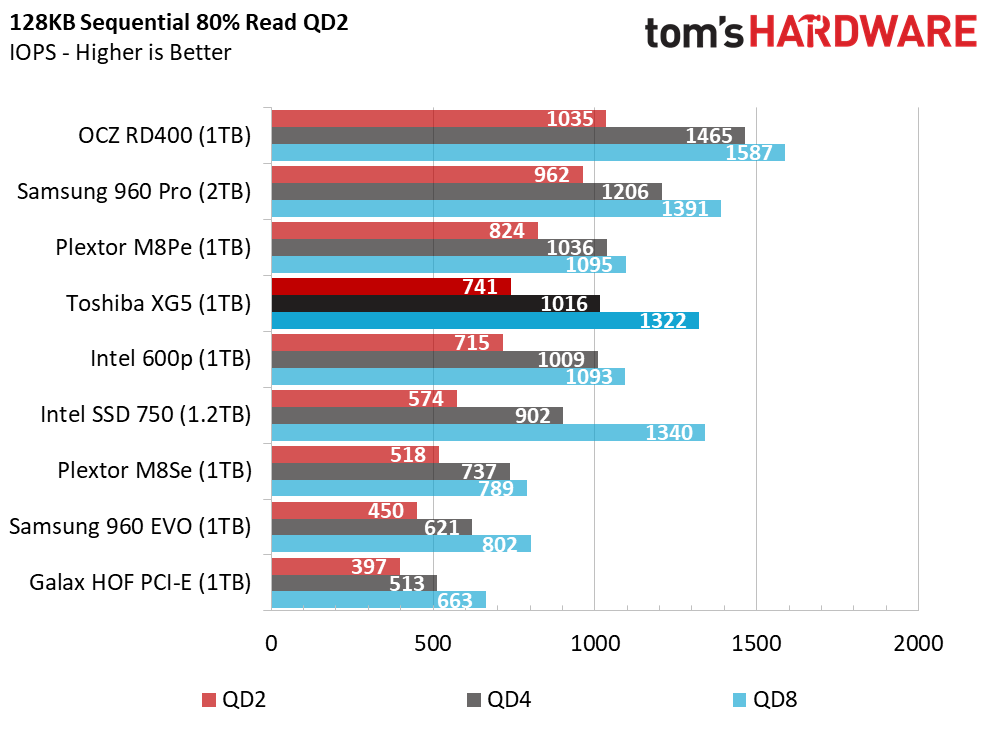
We added charts to better show the scale of the 80-percent read mixed workload test. The NVMe products are not as congested as the SATA SSDs, but the extra chart helps clarify the results. The XG5 is the highest performing drive with TLC flash, but it's well under the RD400.
80% Mixed Random Workload


Mixed random performance is our main concern with TLC flash. The XG5 falls right behind the 850 EVO 1TB at most queue depths.
Sequential Steady-State



The sequential steady-state test reveals a nice uptick on the 100% write end of the chart. All of the other TLC-based SSDs, other than the 850 EVO, fall off during the write portion of the test. Toshiba managed to get MLC-like performance out of BiCS NAND in steady state. It's not as fast as the outgoing 15nm MLC, but it's certainly better than planar TLC.
Random Steady-State
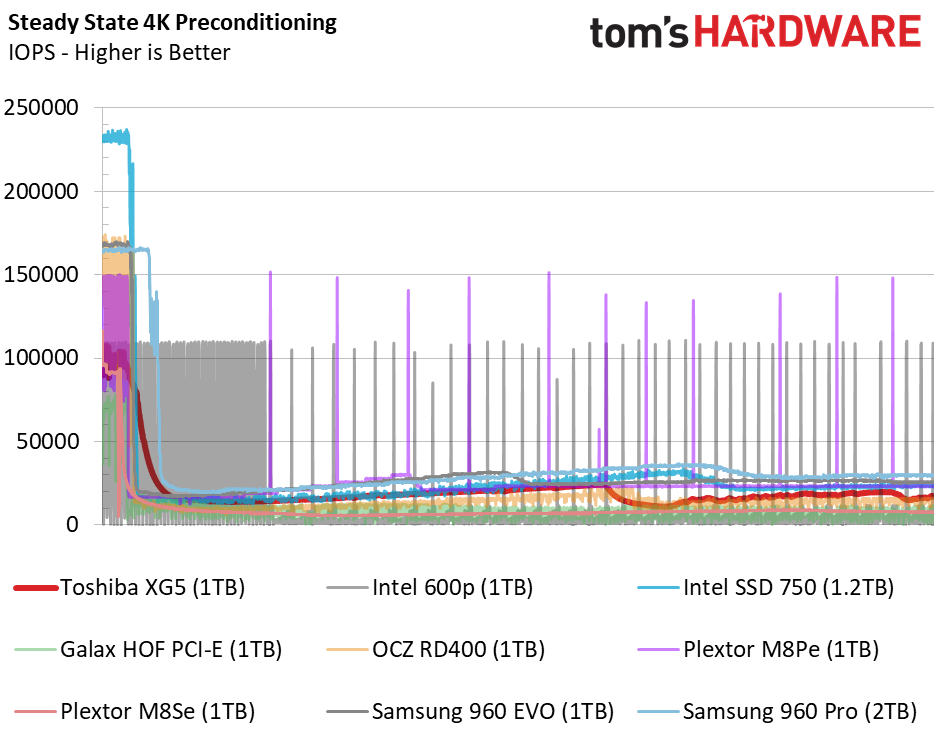

The Toshiba XG5 is one of the first TLC-based SSDs to deliver consistent performance in the steady-state random write test. The XG5 is still 10,000 IOPS slower than the Samsung 850 EVO 1TB, though.
PCMark 8 Real-World Software Performance
For details on our real-world software performance testing, please click here.



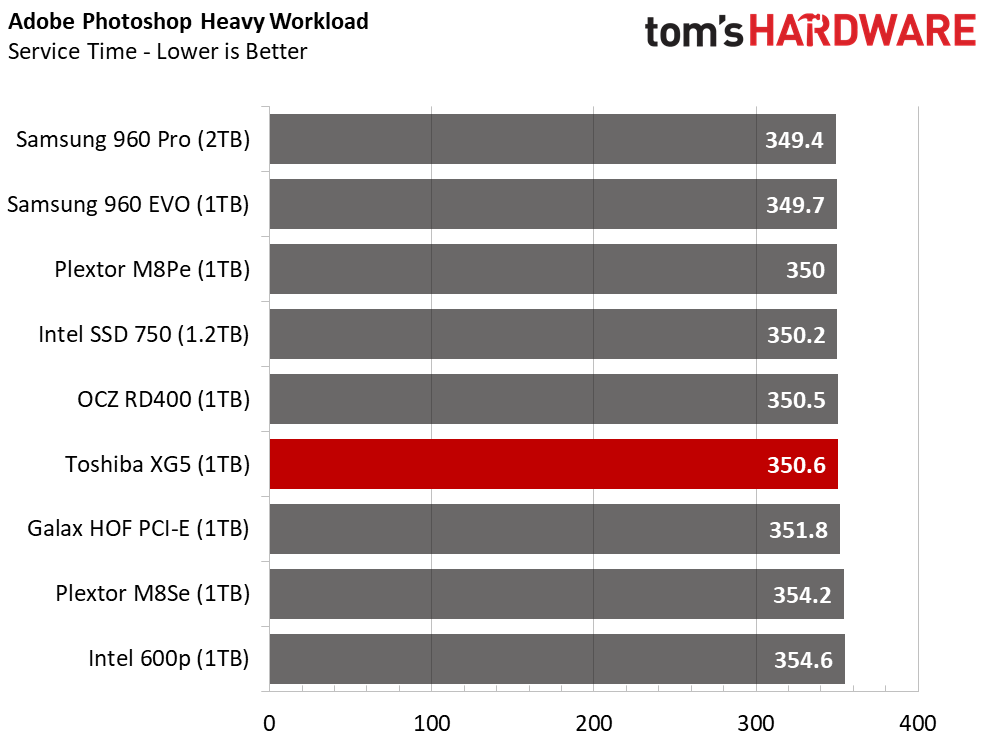






The Toshiba XG5 1TB is impressive even without an optimized driver. In many of the tests the XG5 is right on the heels of the 960 Pro.
Application Storage Bandwidth
Thanks to a 400 MB/s sequential read increase over the RD400 and a high-performance SLC buffer for the data writes, the XG5 is slightly faster than OCZ retail drive. The XG5 even managed to outperform the Intel SSD 750 1.2TB with MLC and an 18-channel controller.
PCMark 8 Advanced Workload Performance
To learn how we test advanced workload performance, please click here.



The Toshiba XG5 delivers consistent performance in our two steady-state tests, but it suffers wild swings in our PCMark 8 Extended Storage Test. This may be the result of thermal throttling during the 24-hour test cycle. It may also be why Toshiba brought this controller to market with an exposed flip-chip design. Phison's E7 ships in both covered and uncovered form, even though we've only seen the covered version once. We inquired about the covered design and were told the extra casing adds a few degrees to the temperature.
Total Service Time



The XG3 / RD400 has a bit of a thermal issue. We used it for an upcoming M.2 cooling article after finding it could benefit from a low-cost cooling solution. The wild service time performance may be a result of throttling, but the RD400 didn't experience the same condition during the test.
Disk Busy Time
We don't know enough about the Toshiba XG5's controller or BiCS NAND to know the source of the increased latency. It carries over to the disk busy time measurements, as well.
During heavy workloads we see latency spikes, but the XG5 settles down during lighter workloads. It's typical behavior for a TLC-based SSD, but we hoped this drive would be different.
Responsiveness Test


Toshiba still has some optimization work. We run the SYSmark 2014 SE Responsiveness Test in a Lenovo Y700-17, and it uncovers latency issues with the XG5. The enclosed space in the notebook may cause thermal throttling. We'll have to explore more before the retail OCZ RD drive comes to market.
Notebook Battery Life


Compared to the XG3 1TB, the Toshiba XG5 1TB adds twenty-one minutes to our MobileMark 2012.5 notebook battery life test. We tested both XG series drives with the Microsoft Windows 10 NVMe driver. We tested the RD400 1TB with the performance optimized driver and it delivered twenty-seven minutes less battery life than the XG5.
MORE: Best SSDs
MORE: How We Test HDDs And SSDs
MORE: All SSD Content

Chris Ramseyer was a senior contributing editor for Tom's Hardware. He tested and reviewed consumer storage.
-
Giroro There's a lot of words padding out the Features and Specifications page ... but very little meaning or context.Reply
So flash manufacturers make flash in different die sizes ... is there anything noteworthy about the die sizes in the XG5? Is a 256Gbit die big or small?
Drive makers tune power consumptions and performance ... ok. Is the XG5 tuned for power or performance. Is the claimed 3,000/2,100 MB/s of sequential read/write particularly high or low compared to other drives?
What is a "flip chip design"? Is that different than other designs, or is there any particular reasons why a drive should/shouldn't use "flip chip design".
Most importantly, WTF is BiCS? What aspect of flash is it even trying to improve? Price? Density? Durability? -
mikewinddale "There were subtle differences between the OEM XG3 and retail RD400. OCZ tuned the RD400 for enthusiasts and included a custom NVMe driver for Windows. The driver makes a big difference."Reply
I had problems with the Windows NVME driver on my XG4, so I used the RD400 driver with the XG4, and it worked perfectly, with no problems.
See https://forums.lenovo.com/t5/ThinkPad-11e-Windows-13-E-and/E570-needs-better-NVMe-driver-support/td-p/3518940?clickid=whh1IG1svXPPQp90UK2rHzHXUkkXJgxNw11DxM0&PID=10451&acid=ww:affiliate:bv0as6&irgwc=1
and
https://www.youtube.com/watch?v=3SwvB_drcJE -
irish_adam Reply19976663 said:There's a lot of words padding out the Features and Specifications page ... but very little meaning or context.
So flash manufacturers make flash in different die sizes ... is there anything noteworthy about the die sizes in the XG5? Is a 256Gbit die big or small?
Drive makers tune power consumptions and performance ... ok. Is the XG5 tuned for power or performance. Is the claimed 3,000/2,100 MB/s of sequential read/write particularly high or low compared to other drives?
What is a "flip chip design"? Is that different than other designs, or is there any particular reasons why a drive should/shouldn't use "flip chip design".
Most importantly, WTF is BiCS? What aspect of flash is it even trying to improve? Price? Density? Durability?
There is this great new website called "Google" which has all the answers to your questions.
I honestly dont mean to be mean, you seem to be lacking in some basic understandings of flash and the flash market which would take someone a little time to explain to you, especially on a forum. You would be far better off just searching for the information yourself, theres plenty of it out there.
-
mikewinddale Reply19976663 said:So flash manufacturers make flash in different die sizes ... is there anything noteworthy about the die sizes in the XG5? Is a 256Gbit die big or small?
Basically, the smaller the die, the more dies it will take to make an SSD of a given capacity. And more dies means more parallelism, which makes the flash drive faster.
For example, suppose an SSD is 1 TB. Then it will take twice as many 256 Gbit dies as 512 Gbit dies to make that 1 TB SSD. And more dies means - as I said - more parallelism.
High-speed SSDs basically rely on internal RAID parallelism. Any given piece of data is read and written to and from multiple dies at once, with the data being split across dies. This way, the SSD can be multiple times faster than any given die.
Compare a high-speed SSD to a flash thumb drive, for example. Most thumb drives are single-channel and lack a sophisticated controller. While they have lower read latency than mechanical hard drives, because there's no mechanical seek, they are also very slow at sequential operations. A flash thumb drive will have virtually no seek latency, but it also has a peak sequential speed of about 20 MB/s, whereas a mechanical hard drive has a seek latency of about 8 milliseconds, but it can achieve about 500 MB/s in sequential operations.
So single-channel flash is actually quite slow in some ways. But a high-speed SSD, by splitting data across multiple dies, can increase its speed several-fold. If you write to every die at 20 MB/s, but the data is split across 50 dies, then you might get 1000 MB/s. (These numbers are just illustrative, and I haven't checked them against any actual SSD model.)
So again, die size matters because the smaller the die, the more dies it takes, and the more parallelism, and the faster the drive.
For this reason, for any given model of SSD, the larger drives are typically faster. The larger drive has more dies, so more parallelism. Sometimes, the smaller SSD cannot use all of its controller's channels. For example, you might find a 1 TB SSD with an 8 channels controller, and 32 dies, with 4 dies per channel. But the 128 GB model of the same brand, with the same 8 channel controller, might have only 4 dies, only has enough dies to use 4 channels. It's an 8 channel controller, but with only 4 dies, only 4 channels get used, so the 128 GB SSD might be half the speed of the 1 TB SSD. A larger SSD will be more able to utilize multiple channels, and similarly, an SSD with smaller dies will have a larger number of dies, so it will be able to utilize more channels.
Of course, smaller dies also make it harder to make a large-capacity drive. So there's a tradeoff. In general, dies are getting larger as drives get larger. This means that a brand-new 128 GB SSD today might be slower than one a few years ago, because a few years ago, the dies were smaller, and it took more of them to make a 128 GB SSD. SSDs are generally getting both faster and larger, so if you buy an SSD that is small by today's standards, it will be slower than a larger SSD.
-
Giroro @MikeWinddaleReply
That's all good and fine... but once again, a dissertation about the parallelism in flash dies doesn't actually tell me anything at all about the XG5 that is supposedly being previewed.
Is the drive more parallel than a typical nvme drive, or is it less parallel? Because all the explanation implies that some aspect of this drive's die size and therefore parallelism is noteworthy ... but in what way? Is that supposed to be explaining why this drive has good sequential write speeds? Did the previewer start the test -expecting- those write speeds?
It's like if you had written 8 paragraphs about why some circuit boards are green and some are blue ... without actually saying what color of circuit board the drive uses. The detail might be interesting, but it doesn't say anything until you give it a point.
What makes this drive unique? Why is it being previewed? What's the thesis statement to any of this? -
CRamseyer The reason why that section is vague is because Toshiba will not tell us. Western Digital / SanDisk will not tell us either. Both companies are fighting like 1st graders on the playground right now. Toshiba just locked WD/SD out of the database files (again) after a judge said they couldn't. There are a few lawsuits on two continents.Reply
It's my guesstimate that the Toshiba factory is only making 256Gbit die right now on a large scale. That would explain why there is a delay in the 2TB XG5 and 2TB Blue 3D / Ultra 3D. Those capacity sizes would require the larger 512Gbit die with the controller WD/SanDisk used.
When I wrote the XG5 article I didn't know about the Blue 3D / Ultra 3D 2TB delay. Now I know and can give a better answer to your question.
So flash manufacturers make flash in different die sizes ... is there anything noteworthy about the die sizes in the XG5? Is a 256Gbit die big or small?
256Gbit is the small BiCS FLASH die and 512Gbit is the large die. 512Gbit is 64GB. Toshiba has the technology to stack NAND 16 die per package. They are not doing it now with BiCS but it's coming. That means with the 512Gbit die they can make a 1TB package. The package is the black thing on the PCB that hold the NAND, the stuff that holds the data.
Paired with the right controller Toshiba could put 8 1TB packages in a single SSD and make an 8TB SSD that resembles a consumer SSD. Some companies have very large SSDs already but they use custom controllers that are not "off-the-shelf". The controllers that support (for example) 32 packages are expensive and generate a lot of heat. It's not the sort of thing you want in your desktop or notebook. The new 512Gbit die size will make very high capacity products possible at reasonable price points.
Companies have used 256Gbit die in the past and Micron has even shipped a 384Gbit die. The odd 384Gbit die caused some other problems but that's not really important in this review other than the experiment was tried and was not as successful as some expected.
Drive makers tune power consumptions and performance ... ok. Is the XG5 tuned for power or performance. Is the claimed 3,000/2,100 MB/s of sequential read/write particularly high or low compared to other drives?
The SSD was tuned for both power consumption and performance. On consumer / client SSDs companies choose a balance. Enterprise products generally favor one or the other but most allow users to manually tune the drive to how you want it. For more information look at the Intel DC P3700 user manual or command line guide.
What is a "flip chip design"? Is that different than other designs, or is there any particular reasons why a drive should/shouldn't use "flip chip design".
This simply means an exposed chip that doesn't have a shell. Flip chips generally run a few degrees cooler but at the same time are exposed and susceptible to breaking if you put a heatsink on with pressure. The corners are fragile.
Most importantly, WTF is BiCS? What aspect of flash is it even trying to improve? Price? Density? Durability?
BiCS FLASH is simple a trademark name for Toshiba's 3D NAND flash. Samsung uses a "special" name too, V-NAND.
3D NAND gives companies two planes to increase density, horizontal and vertical. Planar (2D) NAND is usually 128Gbit (16GB) so we already see a capacity increase. Using less die to build the same capacity size SSD reduces power consumption. 3D also uses a larger lithography process (the switches inside are farther apart) so that also increases endurance.
I hope this information helps. I often forget that not everyone is so involved in the technology. I wrote articles that cover topics like these but that was many years ago. -
reghir I think you meant "making matters" instead ofReply
Western Digital isn't matters easier by trying to block to sale. -
SayNO2BS How come there is no temperature data? It would be really good to know if this thing runs too not for a 24/7 laptop application.Reply





